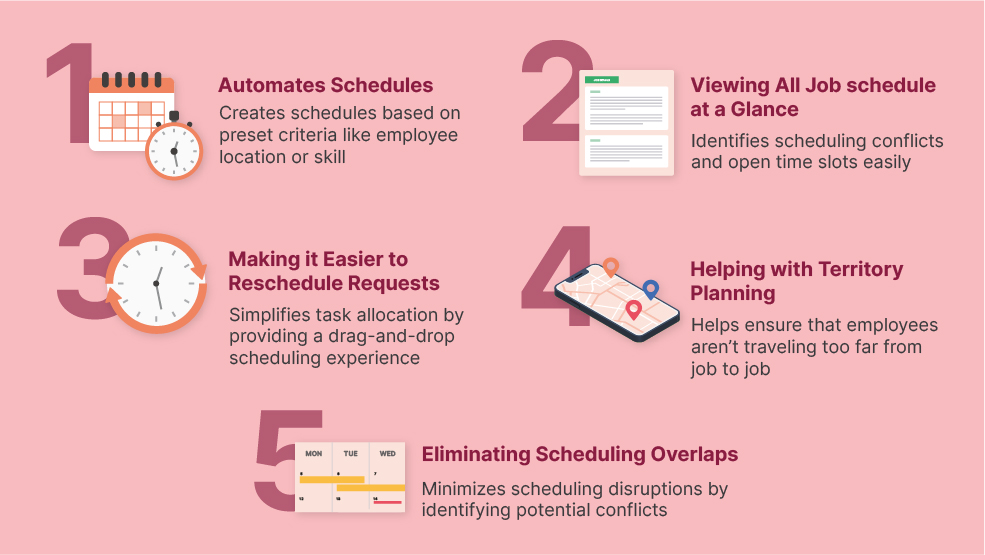Picture this. A preventive maintenance task is meticulously planned, technicians are dispatched with the right job skill sets, and travel routes are optimized for minimal downtime.
But what if we say unplanned downtime costs businesses an average of $5,600 per minute, as per industry research? This translates to a staggering financial burden, highlighting the importance of maximizing equipment and facility uptime. Studies show that unproductive employee hours cost businesses dearly. Around half of employees waste up to three hours daily, translating to an early loss in the thousands per worker. These statistics underscore the critical role that effective field service scheduling plays in maintaining a healthy bottom line.
Maintaining optimal operation is paramount in facility management. Unforeseen equipment failures, malfunctioning systems, and delayed repairs can disrupt workflows, impact productivity, and, ultimately, erode profits. Here’s where efficient field service scheduling for facility maintenance steps in as a game-changer. When you proactively manage field service operations, your facility managers can significantly improve two crucial metrics—uptime and cost efficiency. Let us delve into the intricacies of efficient scheduling, exploring key strategies to overcome common scheduling challenges.
Challenges in field service scheduling
Achieving optimization in field service scheduling is not without its hurdles. Facility maintenance teams encounter a multitude of obstacles that can hinder their scheduling efforts. Let’s look into some of the most common scheduling challenges and their detrimental effects.
Inaccurate data and communication gaps
Incomplete or outdated information regarding equipment history, technician skillsets, and service requirements can severely hamper scheduling accuracy. Fragmented communication between facility managers, dispatchers, and technicians further exacerbates the issue, leading to missed deadlines. Technicians arriving unprepared or sending incorrect parts will happen from time-to-time. If these things happen too frequently, however, it will lead to excessive wasted time and unnecessary delays, prolonging the repair process and increasing downtime.
Dynamic workload fluctuations
You know, facility maintenance is rarely predictable. Emergencies erupt unexpectedly, routine tasks take longer than anticipated, and new work orders arise at a moment’s notice. These dynamic fluctuations can wreak havoc on pre-planned schedules, forcing last-minute adjustments that disrupt technician schedules and potentially leave critical equipment unaddressed. The inability to adapt to a fluid workload can significantly extend repair times and impact overall operational efficiency.
Limited visibility and resource constraints
Traditional scheduling methods often lack real-time visibility into technician locations. They can’t track work progress and inventory availability in real-time. The limited awareness of traditional scheduling makes it challenging to dispatch the most suitable technicians for the right job. Such data insufficiency may lead to poor route optimization and cause delays. All these delays hinder the technicians’ ability to address all maintenance needs in a timely manner.
Inefficient use of technology
Many facilities still rely on manual scheduling processes like spreadsheets and phone calls. These outdated methods are error-prone, time-consuming, and lack the analytical capabilities to optimize schedules for maximum efficiency. Failure to leverage advanced field service management software can lead to inefficient route planning, increased travel time, and higher operational costs.
The consequences of poor scheduling are far-reaching. Unplanned downtime due to poor scheduling disrupts workflows, impacts productivity, and can negatively affect revenue. Inefficient scheduling practices can lead to increased costs when failure to plan, which leads to overtime and unnecessary travel expenses for employees. Many emergency repairs could have been easily avoided with proactive maintenance. In the worst-case scenario, neglected equipment breakdowns can escalate into significant safety hazards, jeopardizing the well-being of employees and occupants.
Why do you need an efficient scheduling system?
At its core, efficient field service scheduling is the strategic planning and allocation of resources. Its ultimate benefit is ensuring the timely completion of work orders while maximizing uptime and minimizing costs. It requires balancing a multitude of factors to achieve optimal performance. Here’s a deeper dive into the key components that define efficient scheduling:
Task prioritization
Not all maintenance tasks are equal. Efficient scheduling prioritizes critical repairs that directly impact production or pose safety hazards. Preventive maintenance tasks are strategically scheduled to address potential issues before they escalate into significant breakdowns. With the help of an efficient scheduling system, you can prioritize tasks effectively. Your facility managers can ensure that essential repairs are addressed promptly, which minimizes downtime for critical operations.
Resource allocation
Efficient scheduling goes beyond simply assigning tasks. It involves strategically allocating the right resources to each job. Factors like technician skillsets, location proximity, work order complexity, and inventory availability all come into play. The ideal scenario is to match a qualified technician who is near the customer’s location with the necessary tools to complete the job faster and more efficiently.
Route optimization
Travel time between work locations can significantly impact a technician’s productivity. Efficient scheduling utilizes route optimization tools to plan travel routes that minimize distance and avoid traffic congestion. Your business can significantly reduce travel costs and allow your technicians to complete more work orders within a designated timeframe.
Real-time visibility
Modern field service management software provides real-time insights into technician locations, work progress, and inventory levels. This transparency empowers dispatchers to adapt to unforeseen circumstances. If a technician finishes a job earlier than anticipated, they can be re-routed to address a higher-priority issue that may have just arisen.
The benefits of efficient field service scheduling are multifaceted. Improved task prioritization translates to faster resolution times for critical repairs, minimizing downtime and its associated economic repercussions. Strategic resource allocation ensures qualified technicians have the tools to efficiently complete tasks, reducing the need for rework or return visits. Optimized routes significantly reduce travel time and fuel consumption, leading to substantial cost savings.
Strategies for boosting uptime with efficient scheduling system
The cornerstone of proactive maintenance lies in meticulously planned preventive maintenance schedules. Leveraging historical equipment data and manufacturer recommendations, prioritize preventive tasks to address potential issues before they snowball into major breakdowns. This forward-thinking approach minimizes the risk of unplanned equipment failures that can cripple operations and lead to costly downtime. A study by the National Institute of Standards and Technology (NIST) found that implementing preventive maintenance programs can reduce equipment failures by up to 30%, which means they increase uptime and significant cost savings.
Take preventive maintenance a step further by integrating predictive maintenance practices into your scheduling strategy. Based on real-time performance data, advanced sensor technology and data analytics can anticipate issues with equipment. By scheduling maintenance interventions based on these predictive insights, you can proactively address minor glitches before they evolve into significant malfunctions that necessitate extended downtime. This approach maximizes equipment lifespan, minimizes the risk of catastrophic failures, and ensures smooth, uninterrupted operations.
Not all technicians are created equal. Efficient scheduling capitalizes on individual strengths by matching each technician’s skill set with the specific demands of each work order. A highly skilled technician adept at complex repairs can be assigned to critical issues, while technicians with preventative maintenance expertise can handle routine tasks. This strategic allocation ensures tasks are completed efficiently by the most qualified personnel, minimizing the likelihood of errors or rework that can prolong downtime.
The best-laid plans can encounter unexpected hiccups. Efficient scheduling systems empower flexibility and real-time adjustments. Field service management software with GPS tracking and communication features allows dispatchers to monitor technician progress, identify scheduling conflicts, and re-route technicians as needed. If a technician finishes a job earlier than anticipated, they can be dispatched to address a higher-priority issue that may have just arisen. This real-time adaptability ensures critical repairs are addressed promptly, minimizing the window of downtime for your facility.
The most skilled technician becomes hamstrung without the necessary tools and parts to complete a job. Efficient scheduling integrates with inventory management systems to ensure parts availability when and where they are needed. Proactive inventory management practices, including minimum stock levels and strategic part ordering, minimize the risk of delays caused by waiting for parts to arrive. This streamlines the maintenance process and swiftly completes equipment repairs, maximizing uptime.
The financial benefits of implementing an efficient field service scheduling system are undeniable. Reduced downtime translates directly to increased revenue generation. Efficient scheduling minimizes the need for emergency repairs, reduces overtime costs associated with rushed repairs, and lowers the financial burden of equipment replacements necessitated by preventable breakdowns. Companies can enjoy substantial fuel and vehicle maintenance cost savings by optimizing resource allocation and travel routes.

Cutting costs with scheduling
While efficient field service scheduling is championed for its ability to maximize uptime, its impact extends far beyond, offering a treasure trove of cost-saving advantages. Let’s look into the key strategies that leverage optimized scheduling to trim facility maintenance expenses.
Minimizing overtime costs
Reactive maintenance approaches often necessitate rushed repairs during off-hours, leading to reliance on overtime pay. Efficient scheduling flips the script. By prioritizing preventive maintenance and proactively addressing potential issues before they occur, the need for emergency repairs and associated overtime expenses is significantly reduced. Furthermore, optimized scheduling empowers technicians to complete more work orders within a designated timeframe, minimizing the need for extended workdays in order to address backlogs.
Optimizing technician utilization
An efficient scheduling system ensures technicians are never left idle. Through skill-based dispatching and real-time route optimization, technicians spend less time traveling between jobs and more time completing billable work. This not only maximizes technician productivity but also reduces overall labor costs.
Strategic inventory management
Efficient scheduling goes hand-in-hand with strategic inventory management. By integrating these two practices, facility managers gain real-time visibility into parts inventory levels and can proactively order necessary supplies to avoid stockouts. This eliminates the costly delays associated with waiting for emergency parts deliveries. Also, implementing minimum stock levels prevents overstocking and the financial burden of carrying excess inventory.
Reduced fuel costs and vehicle maintenance
Travel time is a significant cost driver in field service operations. Efficient scheduling utilizes route optimization tools to plan the most efficient routes possible, minimizing travel distances and avoiding traffic congestion. This reduces fuel consumption and lessens vehicle wear and tear, leading to lower maintenance costs.
Data-driven decision making
Modern field service management software captures a wealth of valuable data on work order completion times, travel distances, and inventory usage. By leveraging business intelligence tools to analyze this data, facility managers can identify areas for improvement and continuously refine their scheduling strategies for maximum cost-effectiveness.
The financial benefits of implementing efficient scheduling practices are substantial. A study revealed that companies that optimized their field service operations achieved an average cost reduction of 15%. Reduced downtime translates directly to increased revenue-generating opportunities. Efficient scheduling minimizes overtime expenses, optimizes technician utilization, and reduces fuel and vehicle maintenance costs.
Also, proactive inventory management eliminates the financial burden of emergency parts purchases and overstocking. By providing valuable data for informed decision-making, efficient scheduling empowers facility managers to continuously optimize their maintenance operations and wring out cost savings across the board. In essence, efficient scheduling is a gift that keeps giving—boosting uptime while delivering significant cost reductions.
Future trends and technologies
The future of field service scheduling is brimming with exciting possibilities. Emerging trends and technologies promise to revolutionize further how facility maintenance teams plan and execute work orders. As data analysis becomes increasingly sophisticated, predictive analytics will play a starring role in scheduling optimization. By leveraging historical data, machine learning algorithms anticipate equipment failures and recommend proactive maintenance interventions. This will enable facility managers to schedule maintenance before issues escalate, minimizing downtime and associated costs.
The proliferation of IoT sensors embedded within equipment will usher in a new era of real-time equipment health monitoring. These sensors will provide continuous data on equipment performance, enabling technicians to identify potential problems remotely and schedule targeted maintenance before minor glitches snowball into significant breakdowns.
The rise of remote monitoring solutions will empower technicians to troubleshoot issues and guide repairs remotely, potentially reducing the need for on-site visits for specific tasks. Augmented reality (AR) technology holds immense promise for field service. AR headsets can provide technicians with real-time information overlays, schematics, and step-by-step instructions, improving repair efficiency and accuracy.
Final thoughts
As we’ve explored, the future of field service scheduling is abuzz with exciting possibilities. Predictive analytics, the proliferation of the Internet of Things (IoT), and the potential of remote monitoring and augmented reality promise to further revolutionize how facility maintenance teams operate. By embracing these advancements and implementing efficient scheduling practices today, facility managers can unlock a future of maximized uptime, optimized costs, and a consistently well-maintained facility.
Boost your facility’s uptime and slash maintenance costs by scheduling tasks with Zuper efficiently. Try our demo today and witness firsthand the transformative impact on your operations.



